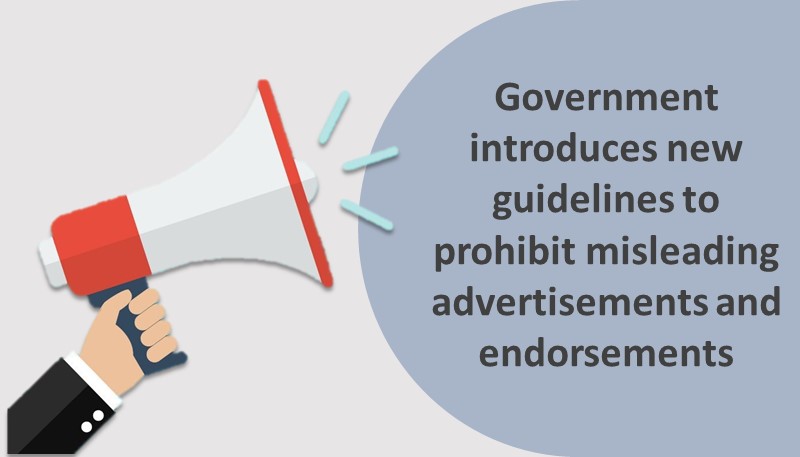Issues of deceptive representations, ambiguous prices, and misrepresentation and falsification of facts by advertisers has more often than not left the Indian consumers exposed and in a vulnerable position. Remember that ad, where a brown-skinned Indian women who is looked down upon by the security guard suddenly turns white-skinned Indian women by applying some fairness cream on her face leaving the guard mesmerized by her “so-called beauty”? This blog is not on the fairness cream and its application, this blog aims to hit to the core of the issue surrounding these advertisements which misrepresent. The market for the Fast-Moving Consumer Goods (FMCG) is huge, for which the FMCG companies resort to advertising in a manner which is far from realty in its description, content and form. At the time when the World was dealing with Coronavirus, and the medical fraternity was still clueless on how to control the spread of virus, FMCG sector saw opportunity and advertised products to be effective enough to prevent Covid-19 without any credibility.
Well, surge in such misleading advertisements impacting negatively the overall the mindset of consumers, demanded proper guidelines to regulate such advertisements. The Central Consumer Protection Authority (CCPA) under the Department of Consumer Affairs has notified the ‘Guidelines for Prevention of Misleading Advertisements and Endorsements for Misleading Advertisements,2022[1] in June 2022. The new guideline on advertisements extends its applicability to all forms of advertisements and to all manufacturers, service providers, traders, advertising agencies and endorsers who are associated with such advertisement. These guidelines provide for a detailed explanation on what constitutes a genuine advertisement and has no negative impact upon the consumers. We, being a compliance management solutions providers and one of the reputed legal-tech firms in India, take the onus of giving you proper guidance and ways to counteract from these misleading advertisements.
Key Points to be adhered to while advertising of any goods/products/ services laid down under the new Guidelines are:
1. Non-Misleading and Valid Advertisement: An advertisement qualifies as a valid and non-misleading advertisement if it –
-
-
Contains Truthful and Honest Representation.
-
Does not mislead consumers by exaggerating accuracy/scientific validity/practical usefulness/capability/performance.
-
Does not represent rights conferred by law
-
Does not suggest the advertisement to contain universally accepted claims, because it has specific informed or scientific opinion in the advertisement claims.
-
In case of failure to purchase the advertised goods or services, it must not mislead the consumers/ families of the nature or extent of risk to their personal security.
-
Must not contain unsubstantiated claims, which are merely based on publications.
-
Complies with other sector-specific laws, rules, and regulations.
-
2. Bait Advertisement: Bait advertisements, i.e., advertisements where goods or services are offered for sale at a lower price to attract customers must satisfy the following conditions:
-
-
The goods/services must be intended to be sold at offered price
-
Must ensure adequate supply of that goods/ services to meet foreseeable demand
-
Must clearly specify about their limited liability
-
Must not mislead consumers about marketing conditions
-
3. Free claim Advertisement: An advertisement in order to be qualified as free claim advertisement must satisfy the following conditions-
-
-
Must not describe goods or services as ‘free’ or ‘without charge’ if consumer has to pay anything over the unavoidable cost
-
Clearly state the extent of commitment required from consumer to avail a free offer
-
Should not describe goods, products, or services as free, if consumer has to pay for packaging/ handling
-
Should not represent a ‘satisfaction or your money back’ offer as a free trial
-
Should not reduce the quality or quantity of the goods, product or service
-
4. Prohibition on Surrogate Advertising: The Guidelines prescribes for prohibition on surrogate advertisement. However, it provides for an exception, stating that a brand used for ‘prohibited’ goods / products/ services could advertise for other goods, as long as it does not violate the guidelines.
5. Child Targeted Advertisement: The new guidelines have laid down detailed conditions on children’s advertisements, keeping in mind the vulnerability of children’s mind. Some of the important conditions laid down under the guidelines are:
-
-
Such advertisement must not take advantage of children’s inexperience, credulity or sense of loyalty
-
Such advertisements shall not exaggerate the feature of goods product or service to lead children to have unrealistic expectations
-
Advertisement for junk foods cannot be aired during a program meant for children or on a channel meant exclusively for children
-
Shall not claim any health or nutritional claims or benefits without being adequately and scientifically substantiated by a recognized body
-
Shall not promote negative body image in children.
-
6. Disclaimers: The disclaimers in an advertisement must comply with the following requirements:
-
-
It must be in the same language as the claim
-
The font used in a disclaimer must be the same as that used in the claim
-
Must be placed at a prominent and visible place on the packaging
-
Must be displayed in sync with the voice over at the same speed as that of original claim
-
Must be clearly visible to a normally sighted person
-
7. Duties of Manufacturer/Service Provider/Advertiser and Advertising Agency: The new guidelines impose certain duties upon the manufacturers, service providers, advertisers and advertising agency to ensure that:
-
-
All claims, descriptions and comparisons made in an advertisement which relates to matter of objectively ascertainable facts must be capable of being substantiated and prove such substantiation when required by the Central Authority.
-
Where claims in advertisement is based upon an independent research or assessment, the advertisement must indicate the source of such independent research or assessment
-
An advertisement must not contain any reference to a person, firm or institution in a manner which provides for unjustified advantage on the product so advertised
-
An advertisement must not contain statement or visual representations which is likely to mislead consumers about the product advertised
-
An advertisement must not be framed such which abuses the trust of consumers or exploit their lack of experience or knowledge
-
8. Endorsements: A due diligence must be conducted before endorsing a good or service. All endorsements must contain the genuine and honest opinion of the endorser, based on their experience with the goods or service endorsed. However, Indian Professionals (residing in India and overseas) as well as Foreign Professionals are prohibited from endorsing professions which are legally prohibited from being endorsed in an advertisement.
Advertisers take advantage of fear and emotions in society due to the pandemic outbreak or any other reason. False claims advertising is a combination of misinformation and disinformation that is fatal and moral deterioration to global society. True information is of central importance in society to avoid false information to control unexpected damage.
Violation of the above-mentioned requirements in an advertisement under the new guidelines can cost manufacturers, advertisers and endorsers to pay a hefty fine. The CCPA has the power to impose a penalty of INR 10 lakhs on manufacturers, advertisers, and endorsers. And, for subsequent violation the penalty imposed can extend up to INR 50 lakhs. Under the Consumer Protection Act, the CCPA also has the authority to prohibit the endorser from making any endorsements up to 1 year, which can extend to 3 years on subsequent non-compliance.
These guidelines provide a detailed explanation on the kind of advertisement permissible in the market for consumers. The clarity provided for bait advertisements, children advertisement, free claim advertisements and endorsements encourages honest and genuine advertisements and ensures better protection of consumer rights. However, the extent of surrogate advertising remains a grey area.
All the manufacturers, advertisers and endorsers are now under the radar of CCPA. The CCPA has taken 113 actions, out of which 57 notices are related to misleading advertisement, 9 are in relation to violation of consumer rights and the other 47 are because of unfair trade practices. The well known brand to receive notice by the CCPA, was Naaptol for its misleading advertisements and unfair trade practices. Another instance of misleading ad where a company has been fined is that they claimed their goods to be providing protection from Covid-19 and were not able to prove the credibility of the same. [2]
These guidelines are indeed a positive step taken by the Government of India towards ensuring protection of the consumers rights and encouraging advertisements which are honest and not misleading for the public. However, it casts lot of responsibilities upon the manufacturers, traders, advertising agencies as well as endorsers.
Lexplosion Solutions have been aiding organizations in mitigating their risks under these new guidelines by making such organisations aware of their legal and statutory duties and obligations. Our flagship Compliance Management Tool, Komrisk, has been helping FMCG companies in mitigating overall compliance risk. To know more connect with us now!
Written by: Amanya Gangawat
Co Authored by: Anchal Sharma
Disclaimer
All material included in this blog is for informational purposes only and does not purport to be or constitute legal or other advice. This blog should not be used as a substitute for specific legal advice. Professional legal advice should be obtained before taking or refraining from an action as a result of the contents of this blog. We exclude any liability (including without limitation that for negligence or for any damages of any kind) for the content of this blog. The views and opinions expressed in this blog are those of the author/(s) alone and do not necessarily reflect the official position of Lexplosion Solutions. We make no representations, warranties or undertakings about any of the information, content or materials provided in this blog (including, without limitation, any as to quality, accuracy, completeness or reliability). All the contents of this blog, including the design, text, graphics, their selection and arrangement are the intellectual property of Lexplosion Solutions Private Limited and/or its licensors.
ALL RIGHTS RESERVED, and all moral rights are asserted and reserved.
[1] https://consumeraffairs.nic.in/sites/default/files/file-uploads/latestnews/CCPA%20Notification.pdf
[2] https://www.businessinsider.in/india/news/misleading-ads-to-get-10-lakh-penalty-says-govt-body-insisting-14-cos-withdrew-covid-efficacy-ads-after-notice/articleshow/92170866.cms





